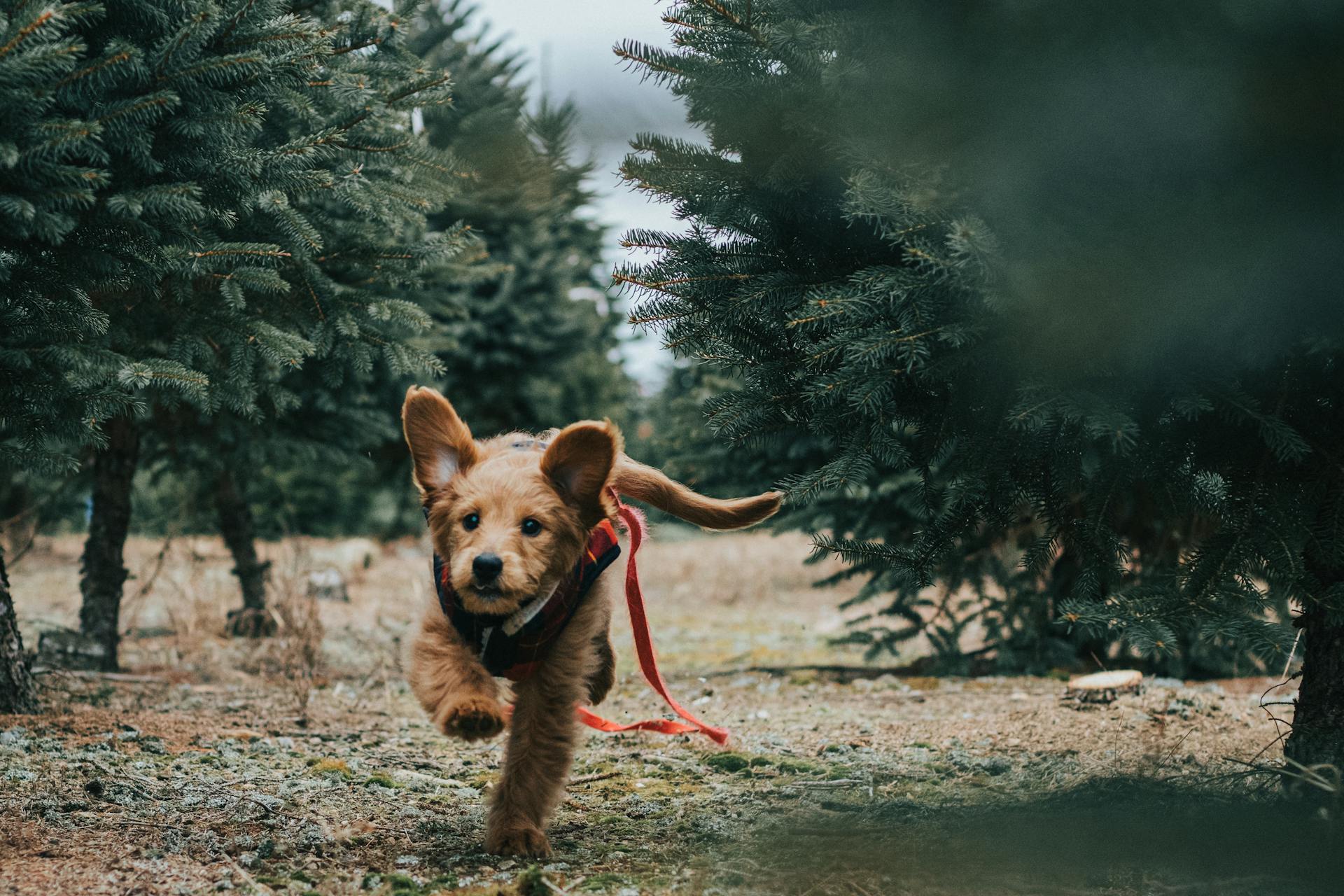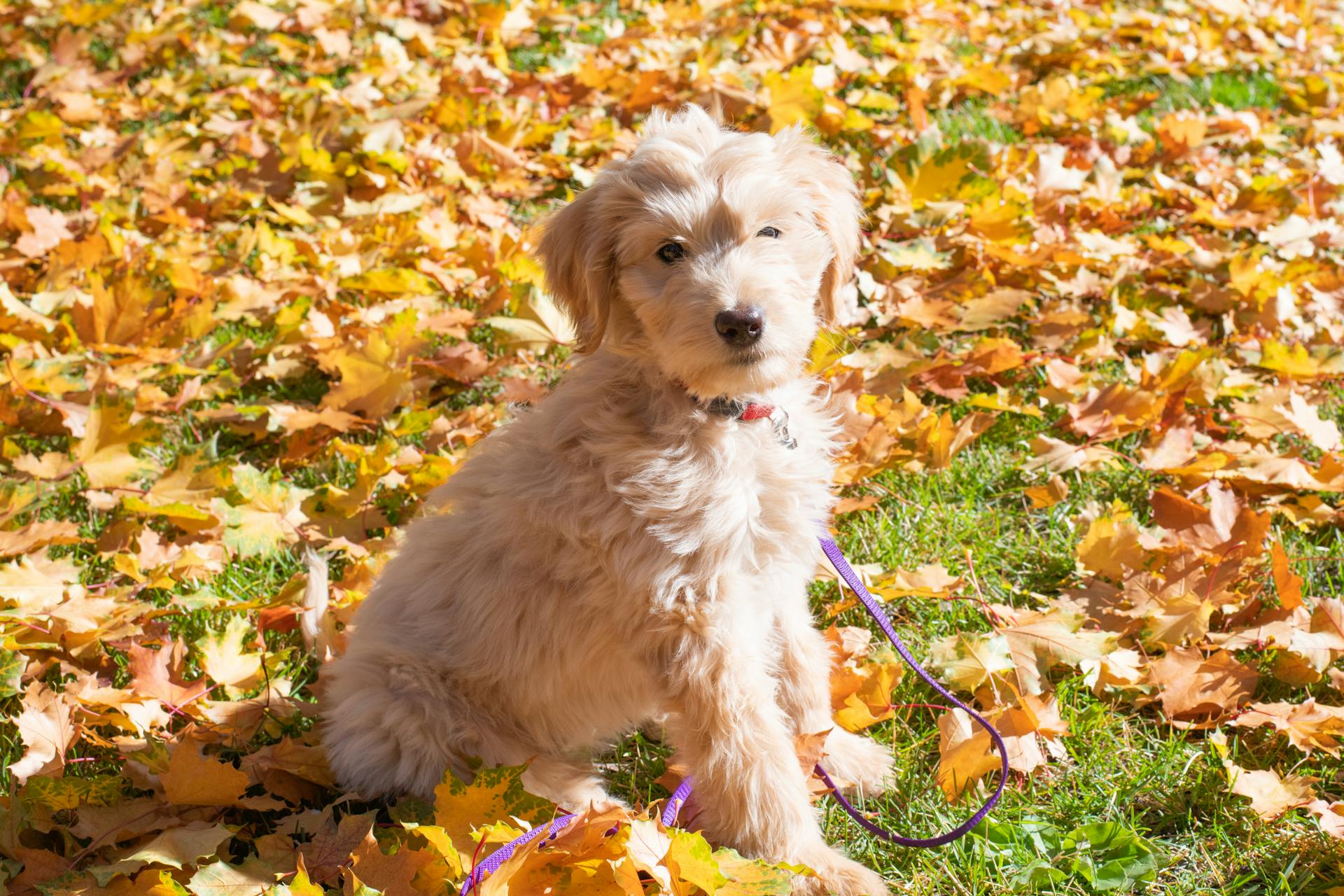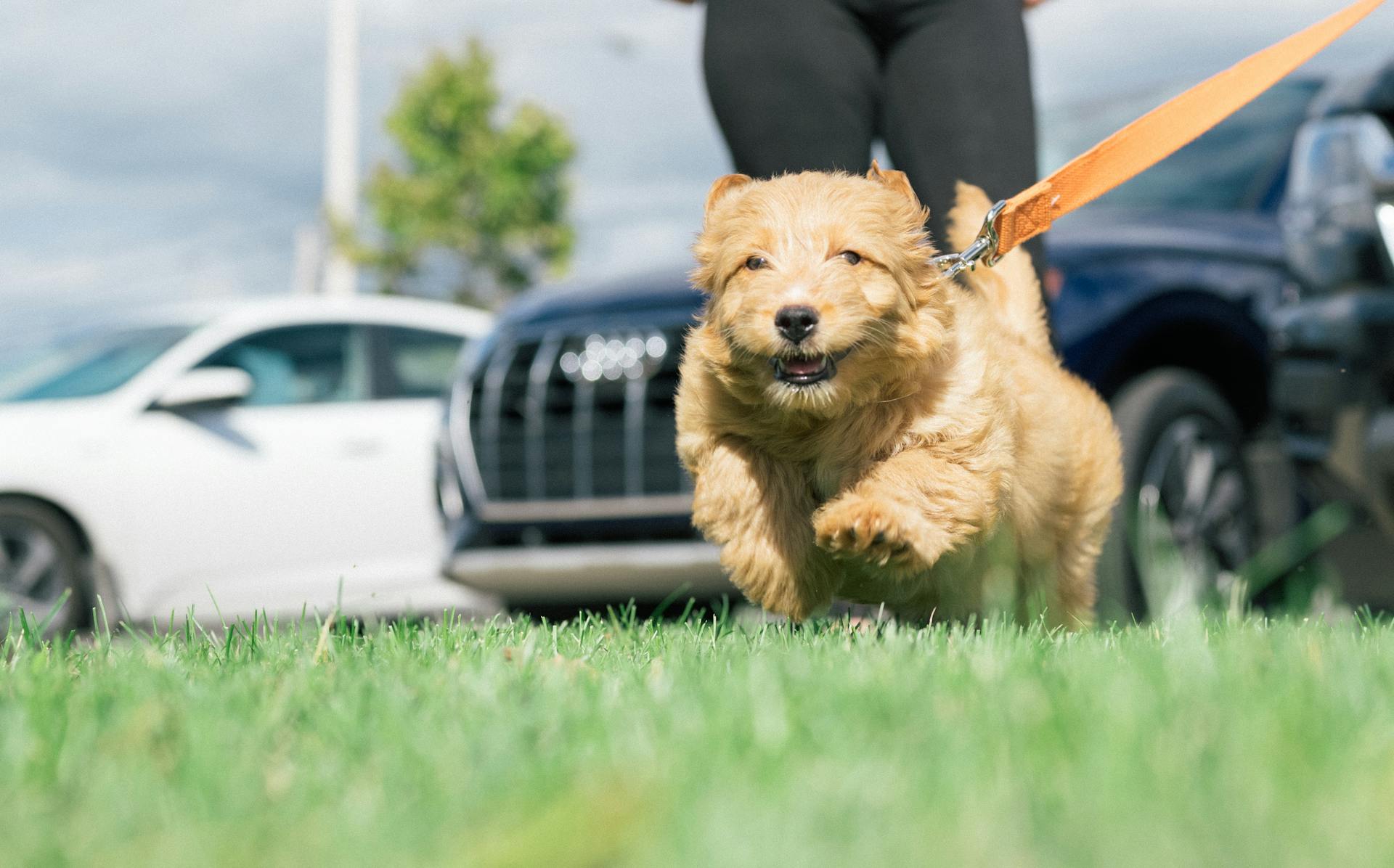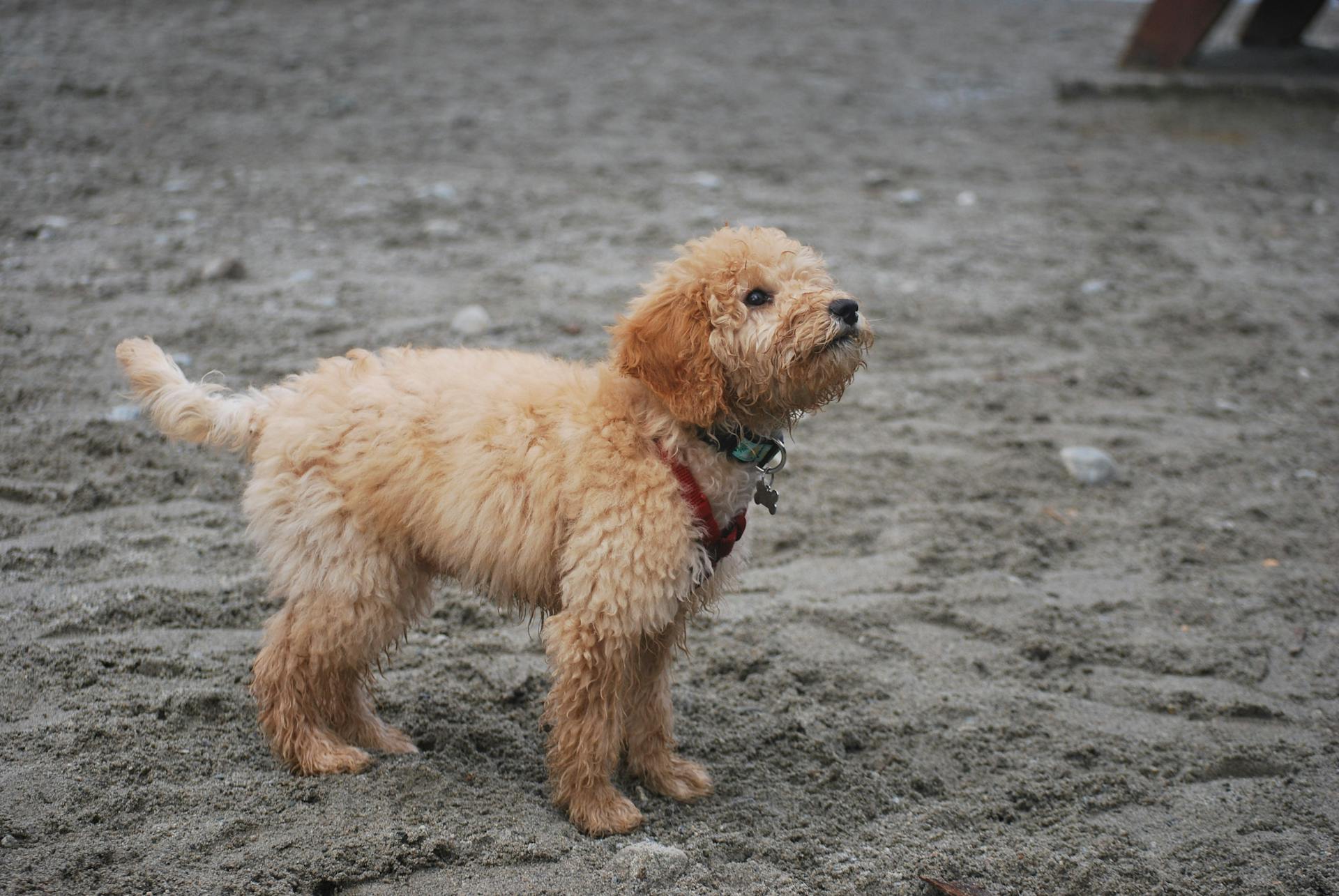
Training a Goldendoodle from puppyhood to adulthood requires patience, consistency, and positive reinforcement. Housebreaking, for example, is a crucial aspect of early training, and Goldendoodles typically take 4-6 months to learn.
Establishing a routine is key, with regular feeding times and potty breaks helping to create a sense of structure and predictability for your puppy. This is especially important during the first few months of life.
Essential Tools and Preparation
As you start training your Goldendoodle, it's essential to have the right tools and preparation in place. A clicker is a great tool to have, as it can help you communicate effectively with your puppy during training.
To make training easier, you'll want to have some special chew toys or treats on hand for rewards. These can be a great motivator for your puppy, especially during the early stages of training.
A leash, collar, and harness are also must-haves for any puppy. They'll help you take your puppy on walks and provide a safe and comfortable way for them to explore their surroundings.
Here are some essential tools to get you started:
- Clicker
- Special chew toys or treats for rewards
- Leash
- Collar and harness
- Crate
- Pet gate
- Blankets and soft things that are exclusively for your puppy
Crate

Crate training is a great way to establish a routine and prevent destructive behavior in your Goldendoodle. You'll need a crate that's the right size for your puppy.
Don't use the crate as a punishment, as this can create a negative association for your pup. Instead, make it a safe and secure space for them to relax.
Younger puppies need to relieve themselves frequently, so be sure to provide plenty of opportunities for them to go outside. You can leave your pup in the crate for a maximum of hours equal to their age in months, stopping at six to eight hours.
A crate can help with housebreaking by making it less appealing for your dog to go potty in the same place they sleep. It's also a great way to prevent unwanted behaviors like chewing on your stuff.
Here are some crate training guidelines to keep in mind:
By following these guidelines, you can help your Goldendoodle feel secure and comfortable in their crate.
Research

Research is a crucial step before bringing home a Goldendoodle puppy. Research canine training theory to understand how dogs learn differently from humans and other pets.
You'll want to learn about the unique way dogs process information and respond to commands. This will help you tailor your training approach to your puppy's needs.
Goldendoodle puppies are blank slates, eager to learn and please their owners. They thrive on affection and attention when they follow a command correctly.
Enrolling in a certified puppy training class can make the training process smoother for both you and your puppy. This will help you develop a strong bond with your dog and set them up for success.
Recommended read: Are Goldendoodles Good Running Dogs
Sample Schedules and Routine
Establishing a routine is key to training a goldendoodle puppy. Consistency is crucial, and a structured routine gives dogs a sense of security.
A goldendoodle puppy's day should start with a consistent schedule, including meal times, bathroom breaks, playtime, naps, and bedtime. Consistency is key in goldendoodle training.
Readers also liked: When Do Goldendoodles Lose Their Puppy Coat
Meals should be used as motivation for training, and rewarding your dog with food is the best way to reinforce good behavior. However, offering endless snacks and treats is a recipe for disaster.
Aim to take your puppy for a bathroom break every one to two hours while house training to prevent accidents. This helps your puppy understand when its next potty break is coming.
Puppies can sleep for up to 18 hours a day, and this time is crucial for their growth and development. Avoid waking a sleeping puppy when possible and maximize the amount of time it spends napping.
Here is a sample schedule to get you started:
Remember to be patient and consistent, and to adjust the schedule as needed to suit your puppy's individual needs.
Training Methods and Techniques
Training a Goldendoodle puppy requires patience and consistency. Every puppy is different and responds uniquely to stimuli, so there’s no one-size-fits-all approach to training methods.
The younger your pup is, the shorter its attention span and the less it understands. This means you should start with easy commands like "sit" and "stay" when your puppy is 8-12 weeks old.
Building a relationship and bond with your pup is essential before starting formal training. This helps them understand what you want and expect from them.
To train your Goldendoodle puppy, it's essential to practice techniques that reinforce good behavior. Research the best options for supplies like crates, clickers, and treats.
Training with love and affection is crucial for a Goldendoodle puppy. Reward them every time they listen to you, and avoid harsh punishments and scolding.
Positive reinforcement is a powerful tool in training a Goldendoodle puppy. Scolding and punishment can make them fear you and lead to long-term problems like destructive behavior.
Your behavior and attitude have a huge impact on your Goldendoodle pup. Always use positive reinforcement and avoid scolding or punishing them for accidents.
Using treats, praise, and affection is key to positive reinforcement with your Goldendoodle puppy. They will respond best to rewards that are paired with enthusiasm and praise.
Correcting bad behavior should be done immediately with the correct behavior, but some bad behaviors should not be acknowledged at all, as this can reinforce them.
Obedience Training
Obedience training is essential for any new goldendoodle owner. Every puppy is different and responds uniquely to stimuli, so there's no one-size-fits-all approach to training methods.
The younger your pup is, the shorter its attention span and the less it understands. A lot of the earliest work involves planting seeds for the future and maintaining that consistent routine. Once it gets to four to six months, it's time to introduce more formal training.
Start with easy commands like "sit" and "stay" when your puppy is between 8-12 weeks old. Stay calm and positive; intimidation and scolding won't do any good. Building a relationship and bond with your pup is crucial before starting formal training.
You can start obedience training immediately with a certified trainer, and it's essential to establish some basic commands from the beginning. By not putting off obedience training, you let your new goldendoodle puppy know precisely what to expect.
Effective Obedience Methods
Researching the best supplies like crates, clickers, and treats is essential for goldendoodle puppy training.
Every puppy is different and responds uniquely to stimuli, so there's no one-size-fits-all when it comes to training methods.
A great way to prevent goldendoodle behavior problems is to shower them with praise and pets when they do something right.
Many goldendoodles respond best to one or more of the following methods: positive reinforcement, clicker training, crate training, and leash training.
Start with easy commands like "sit" and "stay" when training a goldendoodle puppy, as their attention span is shorter at 8-12 weeks old.
Stay calm and positive when training your goldendoodle puppy, as intimidation and scolding won't do any good.
Teach basic commands like "sit", "come", and "stay" first, as mastering these three will give you control over most of your goldendoodle's behavior.
To combat leash-pulling, immediately stop walking and only begin again once your goldendoodle has stopped pulling.
Begin obedience training immediately with a certified trainer to establish basic commands and routines for your new goldendoodle puppy.
Mouthing and Biting
Mouthing and biting are natural behaviors for dogs. They might use biting as a way to get your attention, so make sure you're giving them enough exercise, playtime, and affection.
Chew toys can be a lifesaver in redirecting this behavior. Having some on hand can quickly turn your pup's attention away from biting and towards something more productive.
Biting and mouthing can also indicate that your pup needs more playtime. It's a sign that they're looking for interaction and stimulation.
Redirecting biting behavior with chew toys is a simple yet effective solution. It's a good idea to have a stash of chew toys at home to deal with any biting incidents that might arise.
Barking
Barking is a common behavioral problem that can be addressed with the right approach. You can think about what you want your puppy to do instead of barking, such as sitting still in a designated place.
To train your dog to be quiet, you can use treats to keep them down until you've told them they're released. This technique can be applied in various situations, like when the doorbell rings or when you have guests over.
By designating a specific spot for your puppy to sit, you can help them learn to associate that spot with calm behavior. For instance, you can use a mat or a specific area of the room.
Using positive reinforcement, such as treats and praise, can help your puppy learn to behave calmly in the presence of noise or visitors. This approach encourages good behavior and helps to eliminate unwanted barking.
Socialization and Habituation
Socialization is key to raising a well-adjusted Goldendoodle. They need to get used to new people, pets, and situations from an early age.
Goldendoodles are social creatures that enjoy spending time with their families and meeting other dogs at the dog park. Early socialization is crucial for your pup to get used to new people, pets, and situations.
You can start by setting up puppy playdates and introducing your new dog to friends in a safe environment. This shouldn't be put off because if you wait to socialize your pet, they might start to develop bad habits.
Consider reading: When Were Goldendoodles First Bred
A consistent routine helps with socialization and habituation. Puppies usually need to use the bathroom first thing in the morning, and feeding them at the same time every day is a great way for them to socialize with you and your family.
Here are some key things to keep in mind when scheduling your pup's routine:
- Potty time right after waking up.
- Feed your pup at the same time every day.
- Potty time around 30 to 60 minutes after each meal.
- Playtime or exercise after potty time.
- Puppies usually need to relieve themselves after exercise.
- Once your Goldendoodle pup has gone potty, it's time for a nap.
- Take your pup for a bathroom break after naptime or being in their crate.
- Bedtime every day around the same time is also very useful to enforce a consistent routine.
Remember, puppies around 8-12 weeks of age need smaller portions and more frequent meals, so they'll also need to go potty more frequently.
Taking your Goldendoodle puppy to a dog park is another great way to improve their social skills with humans, puppies, and adult dogs. It's also a great way to get them some exercise and tire them out.
For another approach, see: How to Potty Train Maltese Dogs
Frequently Asked Questions
How do you discipline a Goldendoodle?
To discipline a Goldendoodle, use positive reinforcement techniques like ignoring unwanted behavior and rewarding good behavior, as they tend to be eager to please. A simple "no" or negative marker can also be effective, especially for sensitive dogs.
What is the best age to train a Goldendoodle?
Train your Goldendoodle between 4-6 months for optimal results. Early training sets the foundation for a well-behaved and loyal companion
Sources
- https://www.prideandprejudoodles.com/goldendoodle-daily-schedule/
- https://doodledoods.com/goldendoodle-training-101/
- https://poodles2doodles.com/blog/how-to-train-a-goldendoodle/
- https://copperskyedoodles.com/how-to-train-a-goldendoodle-puppy/
- https://www.sandiego-goldendoodle.com/how-to-train-your-goldendoodle/
Featured Images: pexels.com


